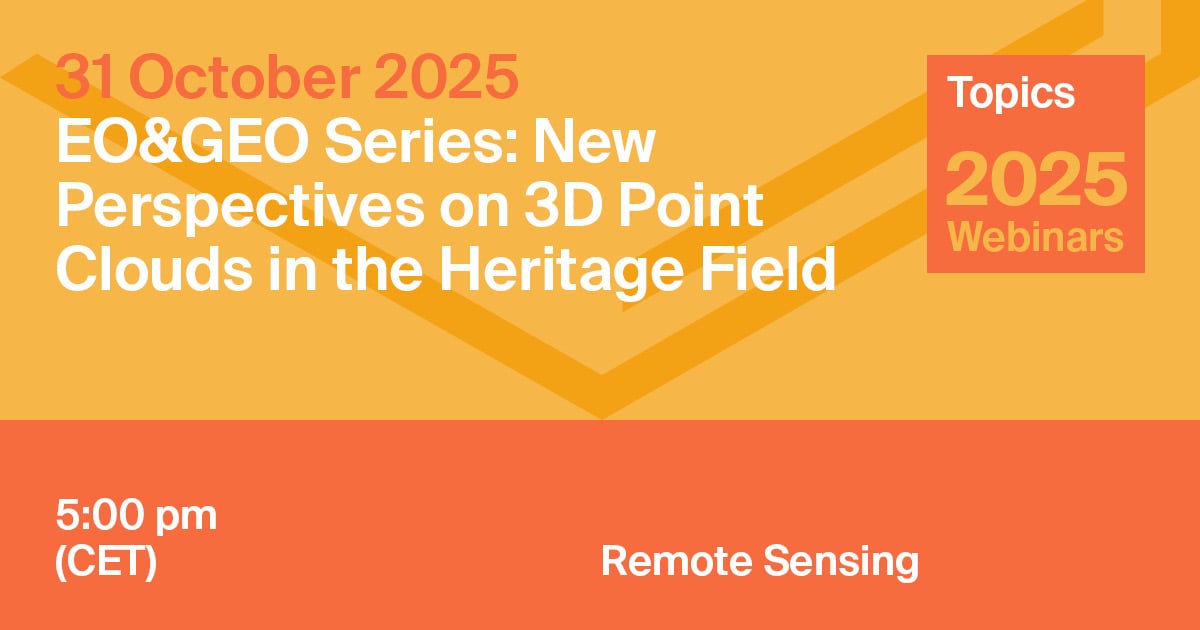
Journal Menu
► ▼ Journal Menu-
- Remote Sensing Home
- Aims & Scope
- Editorial Board
- Reviewer Board
- Topical Advisory Panel
- Photography Exhibition
- Instructions for Authors
- Special Issues
- Topics
- Sections & Collections
- Article Processing Charge
- Indexing & Archiving
- Editor’s Choice Articles
- Most Cited & Viewed
- Journal Statistics
- Journal History
- Journal Awards
- Society Collaborations
- Conferences
- Editorial Office
Journal Browser
► ▼ Journal BrowserNeed Help?
Announcements
30 October 2025
Topics Webinar | EO&GEO Series: New Perspectives on 3D Point Clouds in the Heritage Field, 31 October 2025

Welcome from the Chair:
It is my great pleasure to introduce this webinar, New Perspectives on 3D Point Clouds in the Heritage Field.
In recent years, the integration of artificial intelligence (AI) with advanced 3D documentation techniques has created exciting opportunities for cultural heritage research and conservation. Semantic segmentation methods, empowered by machine and deep learning, now allow us to classify and interpret 3D point clouds, enabling automated recognition of architectural elements.
Equally important is the application of AI-driven workflows for damage detection and structural assessment, where 3D point cloud analysis supports the early identification of damage and the monitoring of heritage assets over time.
Both advances not only deepen our understanding of buildings but also contribute to the comprehensive development of Heritage Building Information Modeling (HBIM) models, fostering the adoption of this interoperable approach.
This webinar gathers cutting-edge research and innovative case studies that demonstrate how these technologies are reshaping documentation, conservation planning, and heritage interpretation. I am deeply grateful to the speakers for their contributions, which collectively provide a forward-looking vision for the digital future of heritage preservation.
I hope this webinar will inspire new methodologies, interdisciplinary collaborations, and the continued integration of 3D point cloud technologies into cultural heritage workflows.
Date: 31 October 2025 at 5:00 p.m. CET | 12:00 a.m. EDT
Webinar ID: 853 5782 4039
Webpage: https://sciforum.net/event/Topics-44
Program:
| Speaker | Presentation Title | Time in CET | Time in EDT |
| Prof. Dr. Luis Javier Sánchez Aparicio | Chair Introduction | 5:00–5:20 p.m. | 12:00–12:20 a.m. |
| Prof. Dr. Roberto Pierdicca | GeoAI: On the Use of Artificial Intelligence for Segmenting 3D Point Clouds | 5:20–5:40 p.m. | 12:20–12:40 a.m. |
| Mr. Pablo Sanz Honrado | Seg4D: A CloudCompare Plugin for Damage Detection Based on 3D Point Clouds | 5:40–6:00 p.m. | 12:40–1:00 p.m. |
| Dr. Andrea di Filippo | Application of 3D Point Clouds for Generating HBIM Models | 6:00–6:20 p.m. | 1:00–1:20 p.m. |
| Q&A Session | 6:20–6:30 p.m. | 1:20–1:30 p.m. | |
| Prof. Dr. Luis Javier Sánchez Aparicio | Closing of Webinar | 6:30–6:40 p.m. | 1:30–1:40 p.m. |
After registering, you will receive a confirmation email containing information on how to join the webinar. Registrations made with academic institutional email addresses will be prioritized.
Unable to attend? Register anyway and we will let you know when the recording is available to watch.
Webinar Chair and Keynote Speakers:
- Prof. Dr. Luis Javier Sánchez Aparicio, Department of Construction and Building Technology, Technical School of Architecture, Polytechnic School of Madrid, Spain;
- Prof. Dr. Roberto Pierdicca, Università Politecnica delle Marche, Dipartimento di Ingegneria Civile Edile e dell’ Architettura, Ancona, Italy;
- Mr. Pablo Sanz Honrado, Institute of Physical and Information Technologies Leonardo Torres Quevedo (ITEFI), Spanish National Research Council (CSIC), Madrid, Spain;
- Dr. Andrea di Filippo, Department of Civil Engineering, University of Salerno, Italy.
Relevant Special Issue:
“New Perspectives on 3D Point Cloud (Fourth Edition)”
Guest Editor: Sara Gonizzi Barsanti
Deadline for manuscript submissions: 31 March 2026
Relevant Papers:
“Hybrid Denoising Algorithm for Architectural Point Clouds Acquired with SLAM Systems”
by Antonella Ambrosino, Alessandro Di Benedetto and Margherita Fiani
Remote Sens. 2024, 16(23), 4559; https://doi.org/10.3390/rs16234559
“Comparison of NeRF- and SfM-Based Methods for Point Cloud Reconstruction for Small-Sized Archaeological Artifacts”
by Miguel Ángel Maté-González, Roy Yali, Jesús Rodríguez-Hernández, Enrique González-González and Julián Aguirre de Mata
Remote Sens. 2025, 17(14), 2535; https://doi.org/10.3390/rs17142535
“Scan-to-HBIM-to-VR: An Integrated Approach for the Documentation of an Industrial Archaeology Building”
by Maria Alessandra Tini, Anna Forte, Valentina Alena Girelli, Alessandro Lambertini, Domenico Simone Roggio, Gabriele Bitelli and Luca Vittuari
Remote Sens. 2024, 16(15), 2859; https://doi.org/10.3390/rs16152859
“3D Reconstruction of Ancient Buildings using UAV Images and Neural Radiation Field with Depth Supervision”
by Yingwei Ge, Bingxuan Guo, Peishuai Zha, San Jiang, Ziyu Jiang and Demin Li
Remote Sens. 2024, 16(3), 473; https://doi.org/10.3390/rs16030473




